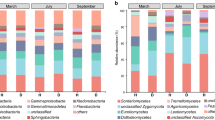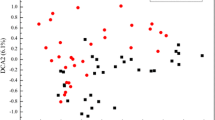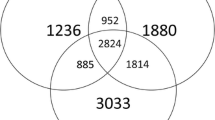Abstract
Soil microorganism has a profound influence on planting growth and disease suppression. However, the difference in microbial community structure between suppressive and root rot-conducive soil and the mechanism of controlling soil-borne diseases by microorganisms in suppressive soil were not clear. To provide a theoretical foundation for prevention and control of root rot, this paper investigated the change of community structure in rhizosphere soil between suppressive and root rot-conducive tobacco fields. Soil samples were collected during before transplanting, vigorous growing period, and mature period of the tobacco, and bacteria and fungi were analyzed using 16S rRNA and 18S rRNA gene sequencing, respectively. Results showed that bacteria were more sensitive to the change between suppressive and root rot-conducive soil, and fungi were more sensitive to the change of different tobacco growth periods. Compared with conducive soil, tobacco suppressive soil can resist the invasion of pathogens, especially fungi, by regulating soil microbial community structure, and the potential pathogen Boeremia was always lower. Fusarium, the root rot pathogen, decreased rapidly in the mature period in suppressive soil. Moreover, norank_o_Gaiellales and unclassified_f_Trichocomaceae had a critical role in suppressive soil in the process of inhibiting root rot, which was obvious in the mature stage. Overall, the results indicated that the composition and structure of the microbial community significantly altered between suppressive and conducive soil along with the growth of tobacco, and suppressive soil could inhibit the occurrence of soil-borne diseases by boosting beneficial bacteria and inhibiting the potential pathogens.





Similar content being viewed by others
References
Doran JW, Zeiss MR (2000) Soil health and sustainability: managing the biotic component of soil quality. Appl Soil Ecol 15(1):3–11
Janvier C, Villeneuve F, Alabouvette C, Edel-Hermann V, Mateille T, Steinberg C (2007) Soil health through soil disease suppression: which strategy from descriptors to indicators? Soil Biol Biochem 39(1):1–23
Rodrigo M, Paolina G, Raaijmakers JM (2013) The rhizosphere microbiome: significance of plant beneficial, plant pathogenic, and human pathogenic microorganisms. FEMS Microbiol Rev 37(5):634–663
Shi L, Du N, Shu S, Sun J, Li S, Guo S (2017) Paenibacillus polymyxa NSY50 suppresses Fusarium wilt in cucumbers by regulating the rhizospheric microbial community. Sci Rep 7:41234
Han T (2016) The effects of Bacillus subtilia Tpb55 strain in controlling tobacco black shank and colonization in tobacco rhizosphere and its effect on micro ecology. Chinese Academy of Agricultural Sciences, Beijing
Rodrigo M, Marco K, Irene DB, Ester D, Menno VDV, Schneider JHM, Piceno YM, Desantis TZ, Andersen GL, Bakker PAHM (2011) Deciphering the rhizosphere microbiome for disease-suppressive bacteria. Science 332(6033):1097–1100
Liu X (2018) Characteristics of tobacco rhizospheric benificial microbiome in the soil suppressive to bacterial wilt disease. Southwest University, Chongqin
Raaijmakers JM, Paulitz TC, Steinberg C, Alabouvette C, Moënne-Loccoz Y (2009) The rhizosphere: a playground and battlefield for soilborne pathogens and beneficial microorganisms. Plant Soil 321(1/2):341–361
Wu L, Lin X, Lin W (2014) Advances and perspective in research on plant-soil-microbe interactions mediated by root exudates. Chin J Plant Ecol 38(3):298–310
Zhang H, Wang R, Chen S, Qi G, He Z, Zhao X (2017) Microbial taxa and functional genes shift in degraded soil with bacterial wilt. Sci Rep 7:39911. https://doi.org/10.1038/srep39911
Yu Q, Yao T (2018) Advances in tobacco root rot by Fusarium. Anhui Agric Sci 46(17):34–36
Qiu R, Li F, Xu M, Li C, Li X, Chen Y, Bai J, Sun Y, Li H (2019) Evaluation of resistance to Fusarium root rot of selected tobacco varieties. China Tob J 25(04):59–63
Chen C, Chu Y, Xie Z, Cao Z, Jiang Y, Sui C, Gao J (2019) Control effect of biological fungicides on tobacco fusarium root rot and influence on agronomic trais of tobacco. J Northwest A & F Univ (Social Science Edition) 47(06):41–46
Liu N, Jiang S, Feng S, Shang W, Xing G, Qiu R, Li C, Li S, Zheng W (2019) A duplex PCR assay for rapid detection of Phytophthora nicotianae and Thielaviopsis basicola. Plant Pathol J 35(2):172–177
Xiang L, Zhou H, Wang H, Li Z, Chen Q, Yu Z (2019) Community structure and diversity of bacteria in different parts of healthy and bacterial wilt tobacco plants. Acta Microbiol Sin. https://doi.org/10.13343/j.cnki.wsxb.20180524
Bao S (2000) Soil agro-chemistrical analysis, 3rd edn. China Agriculture Press, Beijing
Xu N, Tan G, Wang H, Gai X (2016) Effect of biochar additions to soil on nitrogen leaching, microbial biomass and bacterial community structure. Eur J Soil Biol 74:1–8
Rousk J, Bååth E, Brookes PC, Lauber CL, Lozupone C, Caporaso JG, Knight R, Fierer N (2010) Soil bacterial and fungal communities across a pH gradient in an arable soil. ISME J 4(10):1340–1351
Wang R, Deng JQ, Tan J (2016) Ecological protection and remediation of tobacco-growing soils in continuous cropping regions. Chin Tob Sci 37:83–88
Pieterse CM, Zamioudis C, Berendsen RL, Weller DM, Van Wees SC, Bakker PA (2014) Induced systemic resistance by beneficial microbes. Annu Rev Phytopathol 52:347–375. https://doi.org/10.1146/annurev-phyto-082712-102340
Kwak MJ, Kong HG, Choi K, Kwon SK, Song JY, Lee J, Lee PA, Choi SY, Seo M, Lee HJ, Jung EJ, Park H, Roy N, Kim H, Lee MM, Rubin EM, Lee SW, Kim JF (2018) Rhizosphere microbiome structure alters to enable wilt resistance in tomato. Nat Biotechnol. https://doi.org/10.1038/nbt.4232
Zhang X (2018) Analysis of soil microbial characteristics and influencing factors in tobacco field. Zhengzhou University, Zhengzhou
Li X (2017) Barley root rot disease and its effect on rhizosphere soil microecology in Qinghai Tibet Plateau. Gansu Agricultural University, Lanzhou
Zimowska B, Król ED, Furmańczyk A, Abramczyk B, Okoń S (2018) Molecular characterization of Boeremia strasseri the causal agent of black stems and rhizomes rot of peppermint. J Plant Pathol 100(1):13–24. https://doi.org/10.1007/s42161-018-0003-4
Gorny AM, Kikkert JR, Dunn AR, Dillard HR, Pethybridge SJ (2015) Tan spot of lima bean caused by Boeremia exigua var. exigua in New York State, USA. Can J Plant Pathol 37(4):523–528
Zheng H, Guo Z, Zheng W, Wang Z, Zhou J (2016) Functional analysis of FgRab8 and related proteins of Fusarium graminearum. Abstracts of the 2016 Annual Conference of Chinese Society of Mycology, Fuzhou
Berendsen RL, Pieterse CM, Bakker PA (2012) The rhizosphere microbiome and plant health. Trends Plant Sci 17(8):478–486. https://doi.org/10.1016/j.tplants.2012.04.001
Lin S, Li X, Li H, Zhan Y, Lu A, Tian Y, Wang Y (2019) The variation of characteristics of soil microorganism during the growth of tobacco plants. Chin J Soil Fertil 05:14–24
Zeng L, Lin W, Lv S, Wang F, Xia L, Liu W, Wu C, Zhou J, Du C, Cai K (2019) Sustained effects of banana-sugarcane rotation model in the prevention and control of banana fusarium wilt and soil microecological mechanism (I). Chin J Eco-Agric 27:P257-266
Lai B, Dai R, Wu Z, Li F, Lin D, Wang J (2019) Comparison of bacterial community diversity in the rhizosphere soil between healthy pepper plants and plants suffering from Fusarium wilt. Fujian J Agric Sci 034(009):1073–1080
Jin T, Feng Q, Wan J, Wang J (2017) Application of five rhizosphere growth-promoting bacteria in improving plant agronomic traits. China. Patent CN201510541017.2, filed August 28, 2015, and issued March 08, 2017
Yang X, Zhang Z, and Zhu D (2019) Review on secondary metabolites and its biological activities from genus Micromonospora. Nat Prod Res Dev 31(05):908–915, 921
Siddiqui I, Shaukat S (2002) Mixtures of plant disease suppressive bacteria enhance biological control of multiple tomato pathogens. Biol Fertil Soils 36(4):260–268. https://doi.org/10.1007/s00374-002-0509-x
Gao T, Zhang D, Guo X, Hu Y, Jiang J, Wang S, Zhu B (2015) Biocontrol effect of Bacillus sp. 8–32 against soybean root rot. Hubei Agric Sci 54(18):4489–4492
Shen G, Xue Q, Zhang J, Duan J, Wang D, Yang X (2012) Screening, identification and biocontrol potential of antagonistic fungi against strawberry root rot and plant growth promotion. Chin Agric Sci 45(22):4612–4626
Takahashi K, Si F, Hu X, Li S (1988) Life history and classification of Gonatophragmium mori. Foreign Agron-Seric 01:27–30
Qin J, Ma Z, Liu Y, Ning Y (2010) Community characteristics of soil ciliates in Mawushan mountain of Pingliang, Gansu. J Ecol 29(08):1566–1572
Zheng Y, Chen B, Song P, Li Z, Xiao G (2016) Diversity of actinomycetes in rhizosphere soil of potato Intercropping maize system and antagonistic activity against plant pathogenic fungi. Northwest Agric J 25(06):912–920
Jiang H, Ye L, Wang W, Tan G (2016) Identification and biological characteristics of tobacco root rot pathogen in Anhui Province. In: 2016 annual meeting of Chinese society of plant pathology, Nanjing, Jiangsu, China, p 10
Yao X (2019) Study on microecological mechanisms and regulation of tobacco root rot. Southwest University, Chongqin
Acknowledgements
The support of this study from the Scientific and Technological Project of Sichuan Tobacco Company Liangshan Prefecture, China (Grant Number: LSYC201803).
Author information
Authors and Affiliations
Contributions
HL, YW designed this experiment. YC, ZL and YT executed the experiment. YD finished the manuscript.
Corresponding author
Ethics declarations
Conflict of interest
Author Yulan Chen was employed by Liangshan Prefecture Company, Tobacco Company of Sichuan and Zhengquan Lin was employed by Ningnan Branch, Liangshan Prefecture Company, Tobacco Company of Sichuan, and Yangyang Tuo was employed by Dechang Branch, Liangshan Prefecture Company, Tobacco Company of Sichuan. The remaining authors state that this work was conducted without any potential economic and conflict of interest.
Additional information
Publisher's Note
Springer Nature remains neutral with regard to jurisdictional claims in published maps and institutional affiliations.
Supplementary Information
Below is the link to the electronic supplementary material.
Rights and permissions
About this article
Cite this article
Ding, Y., Chen, Y., Lin, Z. et al. Differences in Soil Microbial Community Composition Between Suppressive and Root Rot-Conducive in Tobacco Fields. Curr Microbiol 78, 624–633 (2021). https://doi.org/10.1007/s00284-020-02318-3
Received:
Accepted:
Published:
Issue Date:
DOI: https://doi.org/10.1007/s00284-020-02318-3




